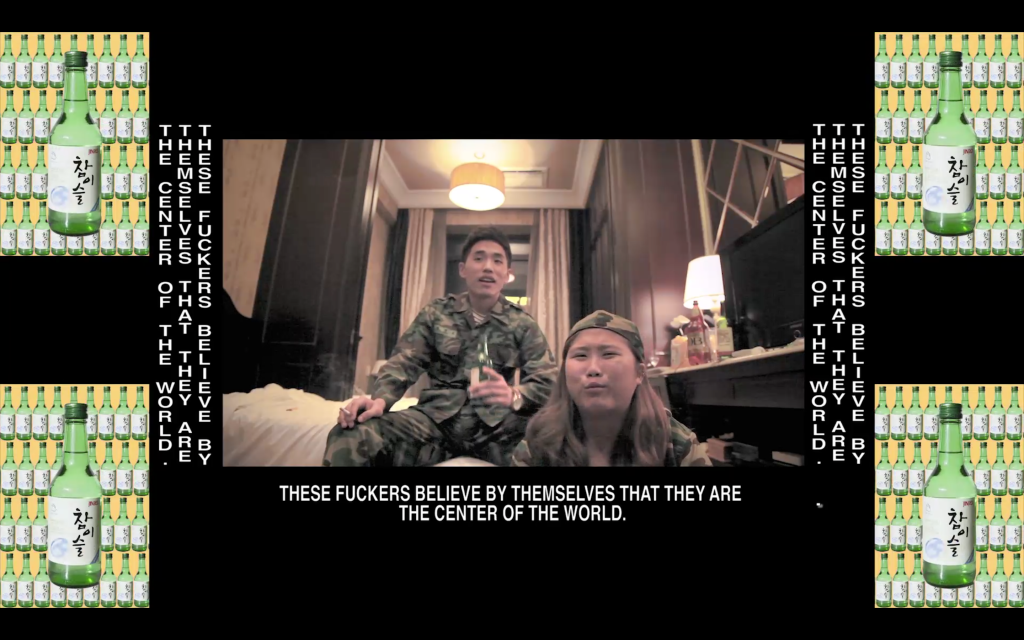1. An Apologist’s Disclaimer
(“Interests: Orientals, the Far East, GAM4GWM ONLY, What does your name mean? ☺, I speak Chinese/Japanese/Korean too!, *inserts slew of Chinese/Japanese/Korean symbols*, Your English is so good!, looking for cute n young friends, I bet you’re really good at Math haha, All Chinese people are ____, You look exactly like my friend, prefer Asians, no Asians pls”)
The initial approach I took when writing this essay was to be confrontational and didactic in articulating the revolutionary demands of yellow or East-Asian people. I felt it was imperative to organize the voices of others like myself into a methodological manifesto of sorts, partly to echo the efforts of other communities of colour, and partly to recoup the lack of other East-Asian bodies in my immediate surroundings and the art ecologies I was participating in. However, a nagging feeling that I was doing “something wrong”, or being unnecessarily antagonistic, consistently delayed my writing. Sentences and sentiments that I once backed so strongly suddenly became belaboured, diffident. Why was I, on some level of consciousness, employing negotiation as self-censorship when I knew and felt the urgency of my cause? Why did I feel the need to add lengthy disclaimers to every slightly agitating remark made, when I knew I was articulating the realities of structural supremacy and disparity that were far from personalized anathema? Was it because of the defensive comments I had received in the past, not only from white people, but also surprisingly from people of colour? Why do we flinch when we confront our own objectification and dehumanization? What does that then say about the degrees to which we are complicit in the larger scheme of systemic oppression (because we all benefit, to some extent, from standing on the backs of others like us)?

It is now part of popular discourse that protesting yellowfacing and acknowledging structural privilege are necessary initial steps towards effecting revolutionary change. It should also be apparent, I hope, that we are not ‘post-’ anything, and that imperialism and neo-colonization pervade every aspect of our lives as people of colour, from securitized national borders to institutions of education and cultural work, and even the privacy of our desires. But perhaps these critiques have been sterilized, nipped in the bud. Maybe it has become fashionable to simply reference an institutionalized politics without actually practicing it or taking direct action. Do we consequently internalize the apathy and strictures that keep us in place? Why else would talk of reparations or separatist spaces make us feel uncomfortable? Moreover, who is allowed access to the tools and resources to make these critiques, and who isn’t? Can we as people of colour, and especially a silenced, fetishized yellow people, tell our own stories? More importantly, when do our stories and representations become worthy of being told and seen? By reformulating the tone of this essay into one primarily of inquiry, rather than iniquity, I also hope to broach two intertwined agendas. Firstly, to question why an angry, vocal, yellow/coloured body is still being demonized (by both Other and Self), and secondly, why we feel the need to justify the injustices leveled against us, and what that says about how much further we have to go in our decolonial efforts.
2. Irreducible, Incendiary
To be yellow is to be denied our right to dissent. Activist struggles for yellow power have been aligned with those of brown and black people. Yet, while brown and black anger is demonized and neutralized at any cost, yellow anger is unnatural and non-threatening. We are expected to nod and comply like “model minorities”, not protest the status quo or let our voices be heard. What does that then say about the differences between white and yellow exceptionalism? Do the social ‘privileges’ thrust upon us by imperialist historicizations come at the cost of other people of colour? Our purchased silence implies that our struggles are over, a thing of the past. Is it possible to be yellow and powerful? Why are we not granted the privilege of complexity? If our bodies are being indelibly represented as ineffectual and submissive, how then do we articulate our demands and intricacies on our own terms, without seeking stamps of approval or legitimacy from the very hegemonic registers that circumscribe us?

In ‘Angry Hotel’ (2014), a video by artist Teejay H., two LGBTQ activists thrash globalized white supremacy while expressing the difficulties of being queer and Korean, such as compulsory military service and enforced Euro-American educational standards. While much of what they say resonates with a decolonial imperative, the cantankerous duo’s aggressive gestures and inebriated Korean profanities often threaten to derail topical discussions. Through a highly unnatural assimilation process, people of colour are expected to tamely organize our pent-up frustrations and generational traumas, for fear of being persecuted as terrorists or radicals. Although rage might potentially mar the coherence of activism, it is also surprisingly productive, not simply because it is opposed to subordination, but because its affective volatility aligns with that of yellow complexities. The pair rightfully argues that their intersectional, localized specificities are often ignored or misinterpreted by institutionalized Western queer discourse. Therefore, their unbridled, inarticulate aggressions become a paradoxically apt medium through which the unknowability of yellow particularities can be channeled and vocalized, without surrendering any more knowledge for neo-colonial co-optation. The duo’s incoherence and untranslatability thus become productive strategies of simultaneous evasion and enunciation, within the equally transient space of their hotel room. Although rarely represented, militarized yellow queerness can relish its temporary airtime as a new-fangled stratagem for articulating revolutionary differences.
To be yellow is to be less-than. On popular television programs, East-Asian men are often infantilized and emasculated, regardless of their proclaimed heterosexuality. They are not permitted the longevity of character development or romantic arcs, and are usually positioned as one-off punch lines, the butts of racist, homophobic jokes. Yellow masculinity is never-man-enough. But at the root of these staged, hyperbolic performances of queer effeminacy is a deep-seated misogyny, a fearful devaluation of all things constru(ct)ed as ‘feminine’, which is then noxiously conflated with racist typecasting. Yellow bodies bear the brunt of intersecting axes of homophobia, misogyny, and racism. Yet, only our subjugation is layered, while our depth and complexity are flattened in favour of superficial trendiness. If yellow masculinities are marginalized and invalidated by white heteronormative patriarchy, how else can we work towards power without debasing other femme-nisms? How can we move beyond the simple bifurcation of submissive effeminacy and phallic machismo?

Artist Yuki Kobayashi performs the contradictions and pluralities of yellow queerness by blending drag and sissy performance with ingrained tropes of virility. In ‘Maria’ (2015), Kobayashi channels his former professional experience as a tennis coach by mimicking the renowned sports star Maria Sharapova. Skirted, he works out with cable weights, physically exhausting himself throughout the durational performance. His muscles tense, perspiration forms, his breathing becomes increasingly labored. In some iterations of the performance, Kobayashi even falls to the ground, completely spent. The representation of an athletic yellow body, one already absent from popular imaginary, is further compounded by Kobayashi’s playful embrace of femme power and drag. He thwarts homonormative desires for masculinity by disidentifying with(in) its toxic regime, engaging instead with a performance of gender power that spans an undecidable spectrum.
III. Origin Story (Myths)
How do we re-value yellow femme expressions when to identify as yellow and femme-nine is to have your femme-ninity denied? Caught in an erotic-exotic bind, East-Asian femmes are expected to be everything and nothing at once. They are expected to encapsulate all manner of fetishistic stereotypes, to be at once infantilized, seductive and hypersexualized, as evidenced in the hackneyed tropes of the guileless geisha or the busty, anime schoolgirl. She has to be innocently intriguing, conservative yet provocative, conventional and futuristic. Unsurprisingly, only the fetishist-patriarch is allowed to travel through time and conjure other worlds of desire, while femmes themselves are emptied of agency to serve as receptacles of fantasy eroticism. Does a yellow femme’s beauty still belong to her? Does identifying or adopting these characteristics implicate yellow femmes in their own objectification? Why do we always have to move away from our indigeneity and localities toward ‘Western’ signifiers and geographies to be read as cosmopolitan, contemporary, or anti-imperialist? Who then occupies or owns the markers of our culture?

Artist Zadie Xa treads the fine line between possession and obsession in her carefully crafted tableaux. She deliberately employs oversaturated, almost caricatured, Orientalist aesthetics through forms such as fortune cookies, nail art, straw hats, and take-out boxes to question the Occident’s intrusive preoccupation with proving the legitimacy and purity of the Orient. ‘Where are you really from? Is this authentic Chinese food?’ Yet, the narrative of truth being written is a bastardized, simplified fiction, far from the realities of yellow complexity. In the aftermath, can we still re-occupy these conquered symbols? Did they ever truly belong to us? Xa’s assemblages, such as ‘One Nine 8 3, Tales from a Kasual Cosmic Korean Cypher (Pleasure Island)’ (2015) and ‘Diamond Mami with the Slanted Eyes’ (2014), therefore become testy sites to confront the frustrations of yellow identification. When we decide to use these contested symbols that have been created for or taken from us, does that make us self-reflexive or self-orientalizing? Who labels us ‘Asian’ and what does it mean when it is they or we who use it? By rehashing these overwrought images of yellowness, Xa forces us (both white and of colour) to question the origins of our ignominy and the shallowness of knee-jerk activism.
IV. *Hopeful* Coloured Person
Who is allowed to be conceptual? Can yellowness, in its infinite iterations, be recognized for its beauty, plurality, and agency? In our utopia, it will be possible to be an angry, athletic sissy, to reclaim power without succumbing to patriarchy, as Teejay and Kobayashi’s works attest to. From our imaginations, revolutionary beauty can spring forth. Xa’s installations, functioning almost as blueprints for yellow fantasy realms, often discretely incorporate small clay figurines made in the image of fellow East-Asian womxn. Through an admittedly pleasurable, sensual, and tactile process, Xa proactively moulds a world where its yellow inhabitants become the naturalized, canonic standards of excellence and desire.
Demolish the scarcity model. These hoards are real. **
Binghao Wong curates and writes about intersectional queer life and its representations. Recent curatorial projects include WE ARE LOSING INERTIA (2014) and Asymmetric Grief (2015).
Header image: Teejay H., ‘Angry Hotel’ (2014). Video still. Courtesy the artist.













